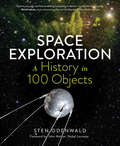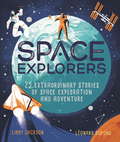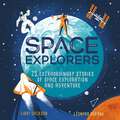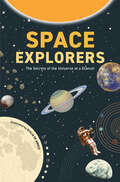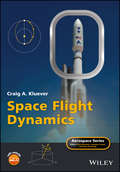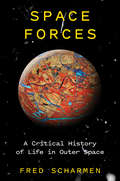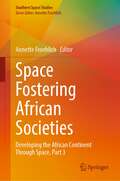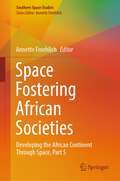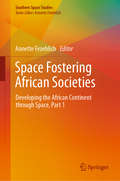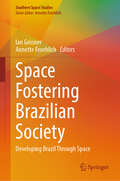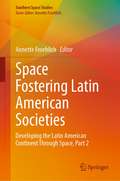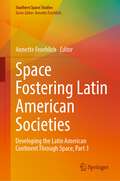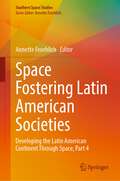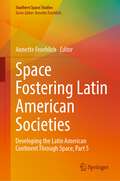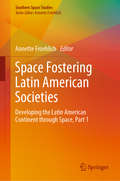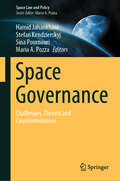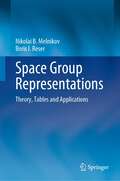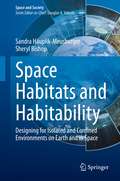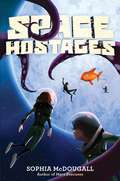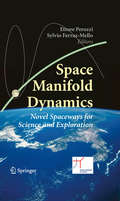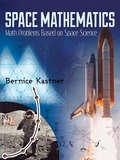- Table View
- List View
Space Exploration: Set of 6 with Teacher Materials Non Common Core Edition (Navigators Ser.)
by Rachel Kranz Nancy WhiteNIMAC-sourced textbook
Space Exploration—A History in 100 Objects: A History In 100 Objects
by Sten OdenwaldThis is no ordinary space book. Within the pages of this eclectic pop-history, scientist and educator Sten Odenwald at NASA examines 100 objects that forever altered what we know and how we think about the cosmos. From Sputnik to Skylab and Galileo’s telescope to the Curiosity rover, some objects are iconic and some obscure—but all are utterly important. The Nebra sky disk (1600 BCE) features the first realistic depiction of the Sun, Moon, and stars.The Lunar Laser Ranging RetroReflector finally showed us how far we are from the Moon in 1969.In 1986, it was the humble, rubber O-ring that doomed the space shuttle Challenger.The Event Horizon Telescope gave us our first glimpse of a black hole in 2019. These 100 objects, as Odenwald puts it, showcase “the workhorse tools and game-changing technologies that have altered the course of space history . . . the tools and devices that, taken together, represent the major scientific discoveries—and celebrate the human ingenuity—of space technology, showing the ways physics and engineering have brought about our greatest leaps in understanding the way our universe works. . . . They make it clear that we have made giant strides in our quest to search ever more deeply into the farthest reaches of the universe—and behind each new discovery is an object that expands our appreciation of space as well as the boundless imagination and resourcefulness we carry within us.”
Space Explorers: 25 extraordinary stories of space exploration and adventure
by Libby JacksonA collection of amazing real-life stories about space exploration and adventure.Do you know the true story of ...*The first astronauts to land on the moon and were nearly stranded there for ever, if it hadn't been for a felt tip pen that saved them?*The 'human computers' that launched NASA's first rockets into space?*The astronaut that trained to go to space by living in underground caves and completing underwater missions?Humans have always been fascinated by the universe, but only a few have been daring enough to travel beyond the Earth.From venturing into space for the first time to building the International Space Station in orbit, the history of space exploration is filled with peril, bravery and strokes of genius.In this beautifully illustrated anthology, spaceflight expert, Libby Jackson, reveals the very best true stories of humankind's thrilling journey to the stars.Grab your space suit and jump aboard - it's time for an astronomical adventure!
Space Explorers: 25 extraordinary stories of space exploration and adventure
by Libby JacksonA collection of amazing real-life stories about space exploration and adventure.Do you know the true story of ...*The first astronauts to land on the moon and were nearly stranded there for ever, if it hadn't been for a felt tip pen that saved them?*The 'human computers' that launched NASA's first rockets into space?*The astronaut that trained to go to space by living in underground caves and completing underwater missions?Humans have always been fascinated by the universe, but only a few have been daring enough to travel beyond the Earth.From venturing into space for the first time to building the International Space Station in orbit, the history of space exploration is filled with peril, bravery and strokes of genius.In this beautifully illustrated anthology, spaceflight expert, Libby Jackson, reveals the very best true stories of humankind's thrilling journey to the stars.Grab your space suit and jump aboard - it's time for an astronomical adventure! (P)2021 Hodder & Stoughton Limited
Space Explorers: The Secrets of the Universe at a Glance!
by Giulia de AmicisDiscover the Secret of the Universe Among the StarsHave you ever wondered what it would be like to travel through space and explore the planets and their moons or to ride the tail of a falling star across the night sky? In Space Explorers, let your imagination fly through the milky way as you adventure through our solar system!Put on your space suit and blast off into the cosmos! Read about the wonders of space and imagine whizzing through the universe towards undiscovered territory like the great astronauts and space explorers before you. This space exploration book will blow your mind! Learn all about the important achievements of humankind in the conquest of space and the secret of the universe in this fascinating discovery of space book.Inside this astronomy book for kids 8-10, you’ll find:Solid scientific data organized into easily digestible infographic platesAn inspiring space exploration book to encourage your curious mind Amusing curiosities, space facts, and out of this world illustrations If you liked space travel books for kids like The Fascinating Space Book for Kids, Our Solar System, or MinuteEarth Explains, you’ll love Space Explorers.
Space Farming (Fountas & Pinnell Classroom, Guided Reading Grade 6)
by James BuckleyMmm Mmm Martian Food Fast Forward to the 2010s Astronauts aboard the International Space Station tend an edible garden. They experiment—successfully—with growing lettuce and other veggies in space. And Beyond … Humans might be living on Mars in the foreseeable future. Of course, they'll need to eat—so plans for Martian farms are already in the works. Mmm Mmm Martian Food Scientists plan to send astronauts to Mars by the 2030s. After that, there could be human settlements on Mars. But what will the spacefarers eat? There are plans for that too—and they involve growing lettuce, lentils, and other veggies. Read this book to find out about the latest ideas for making the Red Planet green! NIMAC-sourced textbook
Space Flight Dynamics (Aerospace Series)
by Craig A. KlueverThorough coverage of space flight topics with self-contained chapters serving a variety of courses in orbital mechanics, spacecraft dynamics, and astronautics This concise yet comprehensive book on space flight dynamics addresses all phases of a space mission: getting to space (launch trajectories), satellite motion in space (orbital motion, orbit transfers, attitude dynamics), and returning from space (entry flight mechanics). It focuses on orbital mechanics with emphasis on two-body motion, orbit determination, and orbital maneuvers with applications in Earth-centered missions and interplanetary missions. Space Flight Dynamics presents wide-ranging information on a host of topics not always covered in competing books. It discusses relative motion, entry flight mechanics, low-thrust transfers, rocket propulsion fundamentals, attitude dynamics, and attitude control. The book is filled with illustrated concepts and real-world examples drawn from the space industry. Additionally, the book includes a “computational toolbox” composed of MATLAB M-files for performing space mission analysis. Key features: Provides practical, real-world examples illustrating key concepts throughout the book Accompanied by a website containing MATLAB M-files for conducting space mission analysis Presents numerous space flight topics absent in competing titles Space Flight Dynamics is a welcome addition to the field, ideally suited for upper-level undergraduate and graduate students studying aerospace engineering.
Space Forces: A Critical History of Life in Outer Space
by Fred ScharmenThe radical history of space exploration from the Russian Cosmists to Elon MuskMany societies have imagined going to live in space. What they want to do once they get up there - whether conquering the unknown, establishing space "colonies," privatising the moon's resources - reveals more than expected. In this fascinating radical history of space exploration, Fred Scharmen shows that often science and fiction have combined in the imagined dreams of life in outer space, but these visions have real implications for life back on earth.For the Russian Cosmists of the 1890s space was a place to pursue human perfection away from the Earth. For others, such as Wernher Von Braun, it was an engineering task that combined, in the Space Race, the Cold War, and during World War II, with destructive geopolitics. Arthur C. Clark in his speculative books offered an alternative vision of wonder that is indifferent to human interaction. Meanwhile NASA planned and managed the space station like an earthbound corporation. Today, the market has arrived into outer space and exploration is the plaything of superrich technology billionaires, who plan to privatise the mineral wealth for themselves. Are other worlds really possible? Bringing these figures and ideas together reveals a completely different story of our relationship with outer space, as well as the dangers of our current direction of extractive capitalism and colonisation.
Space Fostering African Societies: Developing the African Continent Through Space, Part 3 (Southern Space Studies)
by Annette FroehlichThis peer-reviewed book provides detailed insights into how space and its applications are, and can be used to support the development of the full range and diversity of African societies, as encapsulated in the African Union’s Agenda 2063. Following on from Part 1 and 2, which were highly acclaimed by the space community, it focuses on the role of space in supporting the UN Sustainable Development Goals in Africa, but covers an even more extensive array of relevant and timely topics addressing all facets of African development. It demonstrates that, while there have been significant achievements in recent years in terms of economic and social development, which have lifted many of Africa’s people out of poverty, there is still a great deal that needs to be done to fulfill the basic needs of Africa's citizens and afford them the dignity they deserve. To this end, space is already being employed in diverse fields of human endeavor to serve Africa’s goals for its future, but there is much room for further incorporation of space systems and data. Providing a comprehensive overview of the role space is playing in helping Africa achieve its developmental aspirations, the book will appeal to both students and professionals in fields such as space studies, international relations, governance, and social and rural development.
Space Fostering African Societies: Developing the African Continent Through Space, Part 5 (Southern Space Studies)
by Annette FroehlichThis peer-reviewed book provides detailed insights into how space and its applications are, and can be used to support the development of the full range and diversity of African societies, as encapsulated in the African Union’s Agenda 2063. Following on from Part 1 to Part 4, which were highly acclaimed by the space community, it focuses on the role of space in supporting the UN Sustainable Development Goals in Africa, but covers an even more extensive array of relevant and timely topics addressing all facets of African development. It demonstrates that, while there have been significant achievements in recent years in terms of economic and social development, which have lifted many of Africa’s people out of poverty, there is still a great deal that needs to be done to fulfill the basic needs of Africa's citizens and afford them the dignity they deserve. To this end, space is already being employed in diverse fields of human endeavor to serve Africa’s goals for its future, but there is much room for further incorporation of space systems and data. Providing a comprehensive overview of the role space is playing in helping Africa achieve its developmental aspirations, the book will appeal to both students and professionals in fields such as space studies, international relations, governance, social, rural and technical development.
Space Fostering African Societies: Developing the African Continent through Space, Part 1 (Southern Space Studies)
by Annette FroehlichThis book provides detailed insights into how space and its applications are, and can be, used to support the development of the full range and diversity of African societies, as encapsulated in the African Union’s Agenda 2063. Like previous books in the "Southern Space Studies" series, it focuses on the role of space in supporting the UN Sustainable Development Goals in Africa, but it covers an even more extensive array of relevant and timely topics addressing all facets of African development. It demonstrates that, while great achievements have been made in recent years in terms of economic and social development, which has lifted many of Africa’s people out of poverty, there is still much that needs to be done to fulfill the basic needs of Africa's citizens and afford them the dignity they deserve: to this end space is already being employed in diverse fields of human endeavor to serve Africa’s goals for its future, but there is much room for further incorporation of space systems and data. Providing a comprehensive overview of the role space is playing in achieving Africa’s developmental aspirations, the book is of great interest to both students and professionals in fields such as space studies, international relations, governance, social and rural development, and many others.
Space Fostering African Societies: Developing the African Continent through Space, Part 2 (Southern Space Studies)
by Annette FroehlichThis peer-reviewed book provides detailed insights into how space and its applications are, and can be used to support the development of the full range and diversity of African societies, as encapsulated in the African Union’s Agenda 2063. Following on from Part 1, which was highly acclaimed by the space community, it focuses on the role of space in supporting the UN Sustainable Development Goals in Africa, but covers an even more extensive array of relevant and timely topics addressing all facets of African development. It demonstrates that, while there have been significant achievements in recent years in terms of economic and social development, which have lifted many of Africa’s people out of poverty, there is still a great deal that needs to be done to fulfill the basic needs of Africa's citizens and afford them the dignity they deserve. To this end, space is already being employed in diverse fields of human endeavor to serve Africa’s goals for its future, but there is much room for further incorporation of space systems and data. Providing a comprehensive overview of the role space is playing in helping Africa achieve its developmental aspirations, the book will appeal to both students and professionals in fields such as space studies, international relations, governance, and social and rural development.
Space Fostering Brazilian Society: Developing Brazil Through Space (Southern Space Studies)
by Annette Froehlich Ian GrosnerThis peer-reviewed book provides a comprehensive overview of the role of space exploration and technology in Brazil. The Brazilian space sector is currently experiencing rapid growth, with new participants entering the field and space applications increasingly supporting the country's social, economic, and political development. There is a growing recognition of space as a vital component of Brazil's development agenda. Despite significant progress in recent years that has improved the living conditions of many Brazilians and helped lift people out of poverty, much work remains to be done to meet the basic needs of all citizens and ensure they receive the respect they deserve. Space technology is already being utilized in various sectors to help achieve Brazil's future objectives, and there are still ample opportunities to expand the use of space systems and data. The book will be of interest to researchers, professionals, and students in fields such as space studies, international relations, governance, and social and rural development.
Space Fostering Latin American Societies: Developing the Latin American Continent Through Space, Part 2 (Southern Space Studies)
by Annette FroehlichThis peer-reviewed book presents a comprehensive overview of the role space is playing in enabling Latin America to fulfill its developmental aspirations. Following on from the highly acclaimed Part 1, it explains how space and its applications can be used to support the development of the full range and diversity of Latin America societies, while being driven by Latin American goals. The Latin American space sector is currently undergoing a phase of rapid and dynamic expansion, with new actors entering the field and with space applications increasingly being used to support the continent’s social, economic, and political development. All across Latin America, attention is shifting to space as a fundamental part of the continental development agenda, and the creation of a Latin American space agency is evidence of this. Additionally, while in recent years, significant advances in economic and social development have lifted many of Latin America’s people out of poverty, there is still much that needs to be done to fulfill the basic needs of the population and to afford them the dignity they deserve. To this end, space is already being employed in diverse fields of human endeavor to serve Latin America’s goals for its future, but there is still a need for further incorporation of space systems and data. This book will appeal to researchers, professionals and students in fields such as space studies, international relations, governance, and social and rural development.
Space Fostering Latin American Societies: Developing the Latin American Continent Through Space, Part 3 (Southern Space Studies)
by Annette FroehlichThis peer-reviewed book presents a comprehensive overview of the role space is playing in enabling Latin America to fulfill its developmental aspirations. Following on from the highly acclaimed Part 1 and Part 2, it explains how space and its applications can be used to support the development of the full range and diversity of Latin America societies, while being driven by Latin American goals. The Latin American space sector is currently undergoing a phase of rapid and dynamic expansion, with new actors entering the field and with space applications increasingly being used to support the continent’s social, economic, and political development. All across Latin America, attention is shifting to space as a fundamental part of the continental development agenda, and the creation of a Latin American space agency is evidence of this. Additionally, while in recent years, significant advances in economic and social development have lifted many of Latin America’s people out of poverty, there is still much that needs to be done to fulfill the basic needs of the population and to afford them the dignity they deserve. To this end, space is already being employed in diverse fields of human endeavor to serve Latin America’s goals for its future, but there is still a need for further incorporation of space systems and data. This book will appeal to researchers, professionals and students in fields such as space studies, international relations, governance, and social and rural development.
Space Fostering Latin American Societies: Developing the Latin American Continent Through Space, Part 4 (Southern Space Studies)
by Annette FroehlichThis peer-reviewed book presents a comprehensive overview of the role space is playing in enabling Latin America to fulfil its developmental aspirations. Following on from the highly acclaimed Parts 1 to 3, it explains how space and its applications can be used to support the development of the full range and diversity of Latin America societies, while being driven by Latin American goals. The Latin American space sector is currently undergoing a phase of rapid and dynamic expansion, with new actors entering the field and with space applications increasingly being used to support the continent’s social, economic, and political development. All across Latin America, attention is shifting to space as a fundamental part of the continental development agenda, and the creation of a Latin American space agency is evidence of this. Additionally, while in recent years, significant advances in economic and social development have lifted many of Latin America’s people out of poverty, there is still much that needs to be done to fulfil the basic needs of the population and to afford them the dignity they deserve. To this end, space is already being employed in diverse fields of human endeavour to serve Latin America’s goals for its future, but there is still a need for further incorporation of space systems and data. This book will appeal to researchers, professionals and students in fields such as space studies, international relations, governance, and social and rural development.
Space Fostering Latin American Societies: Developing the Latin American Continent Through Space, Part 5 (Southern Space Studies)
by Annette FroehlichThis peer-reviewed book presents a comprehensive overview of the role space is playing in enabling Latin America to fulfil its developmental aspirations. Following on from the highly acclaimed Parts 1 to 4, it explains how space and its applications can be used to support the development of the full range and diversity of Latin America societies, while being driven by Latin American goals. The Latin American space sector is currently undergoing a phase of rapid and dynamic expansion, with new actors entering the field and with space applications increasingly being used to support the continent’s social, economic, and political development. All across Latin America, attention is shifting to space as a fundamental part of the continental development agenda, and the creation of a Latin American space agency is evidence of this. Additionally, while in recent years, significant advances in economic and social development have lifted many of Latin America’s people out of poverty, there is still much that needs to be done to fulfil the basic needs of the population and to afford them the dignity they deserve. To this end, space is already being employed in diverse fields of human endeavour to serve Latin America’s goals for its future, but there is still a need for further incorporation of space systems and data. This book will appeal to researchers, professionals and students in fields such as space studies, international relations, governance, and social and rural development.
Space Fostering Latin American Societies: Developing the Latin American Continent through Space, Part 1 (Southern Space Studies)
by Annette FroehlichThis book presents a comprehensive overview of the role space is playing in unlocking Latin America’s developmental aspirations. It explains how space and its applications can be used to support the development of the full range and diversity of Latin American societies, while being driven by Latin American goals. The Latin American space sector is currently undergoing a phase of rapid and dynamic expansion, with new actors entering the field and with space applications increasingly used to support the continent’s social, economic, and political development. All across Latin America, attention is shifting to space as a fundamental part of the continental development agenda, and the creation of a Latin American space agency is evidence of this. Additionally, while in recent years, great advances in economic and social development have lifted many of Latin America’s people out of poverty, there is still much that needs to be done to fulfill the basic needs of the population and to afford them the dignity they deserve. To this end, space is already being employed in diverse fields of human endeavor to serve Latin America’s goals for its future, but there is still a need for further incorporation of space systems and data. The book is of great interest to researchers, professionals and students in fields such as Space Studies, International Relations, Governance, Social and Rural Development, and many others.
Space Governance: Challenges, Threats and Countermeasures (Space Law and Policy)
by Hamid Jahankhani Stefan Kendzierskyj Maria A. Pozza Sina PournouriThis book delves into the complexities of space governance, offering innovative solutions for a sustainable future. From the pressing issues facing space governance today to creating a consensus on responsibility, ethics, and frameworks, we aim to answer key questions: (i) What are the current challenges? (ii) How do satellites impact society? (iii) What are the potential negative consequences? From communication and early warning systems to global broadcasting and navigation, satellite technology plays a pivotal role in our daily lives. However, this reliance also exposes vulnerabilities, as any disruption to satellite systems could have disastrous consequences across multiple industries. The rapid development of satellite technology, including drones and UAVs, has ushered in a new era of exploration and exploitation. Yet, this progress brings with it new challenges, particularly in terms of governance. As satellites transcend national boundaries, the dynamics of space governance become increasingly complex, with various entities pursuing their own interests without always considering the broader implications. This book bridges the knowledge gap surrounding space technology and highlights the need for increased governance frameworks, data protection, and disciplined deployment. By addressing issues of control, privacy, and security, we pave the way for a more sustainable and responsible approach to space exploration. Join us on this journey as we navigate the evolving landscape of space governance and chart a course towards a brighter future for all.
Space Group Representations: Theory, Tables and Applications
by Nikolai B. Melnikov Boris I. ReserThis book is devoted to the construction of space group representations, their tabulation, and illustration of their use. Representation theory of space groups has a wide range of applications in modern physics and chemistry, including studies of electron and phonon spectra, structural and magnetic phase transitions, spectroscopy, neutron scattering, and superconductivity. The book presents a clear and practical method of deducing the matrices of all irreducible representations, including double-valued, and tabulates the matrices of irreducible projective representations for all 32 crystallographic point groups. One obtains the irreducible representations of all 230 space groups by multiplying the matrices presented in these compact and convenient to use tables by easily computed factors. A number of applications to the electronic band structure calculations are illustrated through real-life examples of different crystal structures. The book's content is accessible to both graduate and advanced undergraduate students with elementary knowledge of group theory and is useful to a wide range of experimentalists and theorists in materials and solid-state physics.
Space Habitats and Habitability: Designing for Isolated and Confined Environments on Earth and in Space (Space and Society)
by Sandra Häuplik-Meusburger Sheryl BishopThis book explores creative solutions to the unique challenges inherent in crafting livable spaces in extra-terrestrial environments. The goal is to foster a constructive dialogue between the researchers and planners of future (space) habitats. The authors explore the diverse concepts of the term Habitability from the perspectives of the inhabitants as well as the planners and social sciences.The book provides an overview of the evolution and advancements of designed living spaces for manned space craft, as well as analogue research and simulation facilities in extreme environments on Earth. It highlights how various current and future concepts of Habitability have been translated into design and which ones are still missing. The main emphasis of this book is to identify the important factors that will provide for well-being in our future space environments and promote creative solutions to achieving living spaces where humans can thrive. Selected aspects are discussed from a socio-spatial professional background and possible applications are illustrated.Human factors and habitability design are important topics for all working and living spaces. For space exploration, they are vital. While human factors and certain habitability issues have been integrated into the design process of manned spacecraft, there is a crucial need to move from mere survivability to factors that support thriving. As of today, the risk of an incompatible vehicle or habitat design has already been identified by NASA as recognized key risk to human health and performance in space. Habitability and human factors will become even more important determinants for the design of future long-term and commercial space facilities as larger and more diverse groups occupy off-earth habitats. The book will not only benefit individuals and organizations responsible for manned space missions and mission simulators, but also provides relevant information to designers of terrestrial austere environments (e.g., remote operational and research facilities, hospitals, prisons, manufacturing). In addition it presents general insights on the socio-spatial relationship which is of interest to researchers of social sciences, engineers and architects.
Space Hostages
by Sophia McdougallFrom bestselling UK author Sophia McDougall comes Space Hostages, an intergalactic quest full of humor, adventure, and, of course, aliens! This hilarious middle grade sequel to Mars Evacuees is perfect for fans of Artemis Fowl and packed with nonstop fun.Young Alice Dare is relieved that at last humans and the alien Morrors are now living peacefully together on Earth. But with an influx of too many Morrors, space is getting a bit tight. To make room for all the Morrors, they've been terraforming a cold little moon in the Alpha Centauri system--and Alice and her friends are invited to the inauguration of the Morrors' new home!But just as they're approaching Alpha Centauri, the kids are kidnapped by the hostile Krakkiluks and must save themselves--and the Eemala people in the process!
Space Law Principles and Sustainable Measures (Space Law and Policy)
by Hamid Jahankhani Stefan Kendzierskyj Maria A. Pozza Sina PournouriThis book helps to bridge the knowledge gap that currently surrounds space technology and its method of exploration and highlights much-needed awareness and attention to an increase in Space Law and sustainable measures. The ever-increasing usage of space-based solutions by both public and commercial entities is producing congestion in the radio frequency spectrum as well as orbital slots. The inevitable commercialization of satellite technology will certainly result in a proliferation of privately owned and managed satellite spacecraft in low-Earth orbits. Cyber vulnerabilities in the Air Force and the DoD frequently ignore satellite ground systems. Space ground system cyber security assaults and investigations include those involving satellite control, communications terminal hacking, and GPS spoofing. A continuous cyber security assessment technique is required for space systems to identify, assess, reduce, and address sophisticated cyber threats. Risk-based compliance, regular cybersecurity risk assessments, and a renewed focus on the elimination of system flaws at the time of design are all necessary for space ground and control systems. Due to the absence of a rigid regulatory framework, satellites play a significant part in the production of space debris, which is a source of increasing worry. Such debris manufactured artificially contributes greatly to the destruction of the environment in Earth’s orbit. There is not a single framework in existence that can appropriately govern contemporary concerns like the security of satellite data and debris in orbit. The Department of Defence (DoD) is now responsible for monitoring all objects in space; however, it cannot require satellite operators to take precautions against potential collisions.
Space Manifold Dynamics
by Sylvio Ferraz-Mello Ettore PerozziThe term "Space Manifold Dynamics" (SMD) was proposed during the workshop "Novel Spaceways for Scientific and Exploration Missions" for describing new types of spacecraft trajectories that could revolutionize how space missions are designed. Obtained by applying the dynamical system approach to mission design, these trajectories represent a fascinating alternative to elliptic motion and provide a deeper understanding of the classical three and N-body problems in celestial mechanics. This book gives a state-of-the-art overview of this new field of study together with applications of an interdisciplinary nature involving planetary science, astrophysics and the manned exploration of the solar system.
Space Mathematics: Math Problems Based on Space Science (Dover Books on Aeronautical Engineering)
by Bernice KastnerCreated by NASA for high school students interested in space science, this collection of worked problems covers a broad range of subjects, including mathematical aspects of NASA missions, computation and measurement, algebra, geometry, probability and statistics, exponential and logarithmic functions, trigonometry, matrix algebra, conic sections, and calculus. In addition to enhancing mathematical knowledge and skills, these problems promote an appreciation of aerospace technology and offer valuable insights into the practical uses of secondary school mathematics by professional scientists and engineers.Geared toward high school students and teachers, this volume also serves as a fine review for undergraduate science and engineering majors. Numerous figures illuminate the text, and an appendix explores the advanced topic of gravitational forces and the conic section trajectories.

